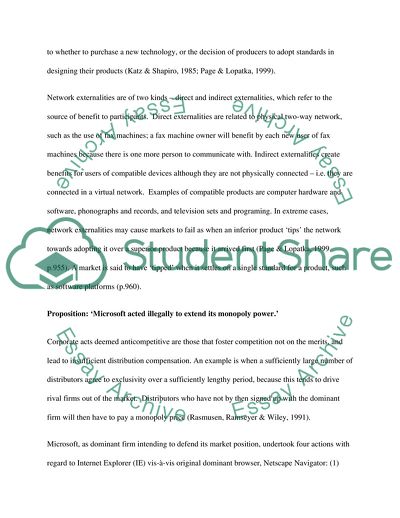Cite this document
(Essay-Microsoft. Briefly explain the concept of network externalities Essay, n.d.)
Essay-Microsoft. Briefly explain the concept of network externalities Essay. https://studentshare.org/macro-microeconomics/1788150-essay-microsoft-briefly-explain-the-concept-of-network-externalities-and-its-importance-for-industrial-economics-present-arguments-for-and-against-the-view-that-microsoft-acted-illegally-to-extend-its-monopoly-power
Essay-Microsoft. Briefly explain the concept of network externalities Essay. https://studentshare.org/macro-microeconomics/1788150-essay-microsoft-briefly-explain-the-concept-of-network-externalities-and-its-importance-for-industrial-economics-present-arguments-for-and-against-the-view-that-microsoft-acted-illegally-to-extend-its-monopoly-power
(Essay-Microsoft. Briefly Explain the Concept of Network Externalities Essay)
Essay-Microsoft. Briefly Explain the Concept of Network Externalities Essay. https://studentshare.org/macro-microeconomics/1788150-essay-microsoft-briefly-explain-the-concept-of-network-externalities-and-its-importance-for-industrial-economics-present-arguments-for-and-against-the-view-that-microsoft-acted-illegally-to-extend-its-monopoly-power.
Essay-Microsoft. Briefly Explain the Concept of Network Externalities Essay. https://studentshare.org/macro-microeconomics/1788150-essay-microsoft-briefly-explain-the-concept-of-network-externalities-and-its-importance-for-industrial-economics-present-arguments-for-and-against-the-view-that-microsoft-acted-illegally-to-extend-its-monopoly-power.
“Essay-Microsoft. Briefly Explain the Concept of Network Externalities Essay”. https://studentshare.org/macro-microeconomics/1788150-essay-microsoft-briefly-explain-the-concept-of-network-externalities-and-its-importance-for-industrial-economics-present-arguments-for-and-against-the-view-that-microsoft-acted-illegally-to-extend-its-monopoly-power.


